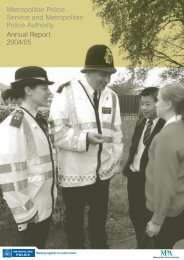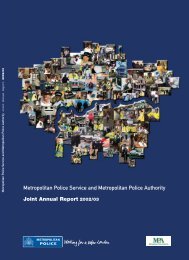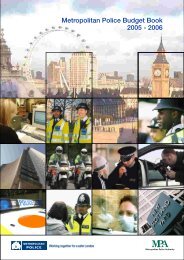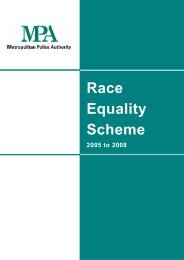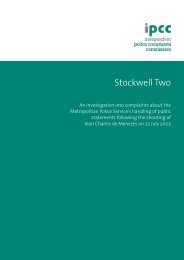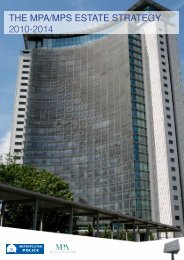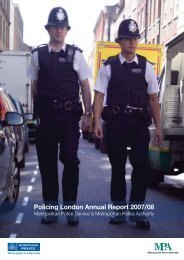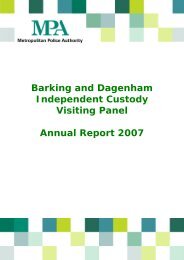14603 MPA AR p2716 REPAGIN.qxd
14603 MPA AR p2716 REPAGIN.qxd
14603 MPA AR p2716 REPAGIN.qxd
Create successful ePaper yourself
Turn your PDF publications into a flip-book with our unique Google optimized e-Paper software.
Metropolitan Police AuthorityAnnual ReportContentsForeword by Toby Harris,Chair of the Metropolitan Police Authority 2Meeting targets 4• Borough meetings • Street crimeScrutiny 5• Rape investigation• Crime and Disorder Reduction PartnershipsStrategy 5Towards the Safest CityPlanning 5Bespoke borough targetsBest Value 5• Consultation • Crime management• Records managementFatal incidents 6Deaths in custody • Suspension • Public confidenceRecruitment 6• Extra officers • Visible ethnic minority recruits• Borough priorityConsultation, diversity and equalities 6• Best value review of consultation• Independent Custody Visitors• Recommendation 61, Stephen Lawrence Inquiry Report• Disproportionality • Damilola Taylor – youth safety• Race hate crimes working group• Post September 11 public reassurance • Race equalityPartnership 8Police pay and conditions 8• Bonus payments • Family friendly policiesCivil support staff pay 8• Pay and grading • Location allowanceAppointments of ACPO rank police officers 9Transport Operational Command Unit 9Professional standards 9ACPO complaints protocol 9Timeliness of complaint investigations 9Finance/Budget 10Estates – PFI projects 10Internal Audit 11In summary 11Appendix 12
<strong>MPA</strong>5ScrutinyThe Authority decided in the year to look at some in-depth areas ofMPS performance by carrying out scrutiny projects. The subjectof the first project was a request by the MPS to look into rapeinvestigation and victim care.The Authority produced a report which found examples of high qualityservice provision in some boroughs. But we concluded that overallthese needed to be improved and standardised across London toensure the best possible service is provided.The scrutiny made 38 recommendations for improvement, all of whichhave been adopted by the MPS.A key recommendation identified an urgent need for three SexualAssault Referral Centres covering London to provide a first classvictim care service.The Authority is planning its second scrutiny project into Crime andDisorder Reduction Partnerships, of which the <strong>MPA</strong> will become astatutory partner in April 2003.As well as looking at how police involvement in these partnershipsworks, this scrutiny will also provide recommendations on how the<strong>MPA</strong> should fulfil its role as a statutory partner. StrategyThere was significant <strong>MPA</strong> input for the development of a mediumtermcorporate strategy for the MPS, although the launch was delayeddue to the new requirement in the Police Reform Act for policeauthorities to issue three-year strategies in March 2003. This led tothe development of ‘Towards the Safest City’ – a framework settingout the likely direction of the MPS pending further nationalrequirements from the Home Office.PlanningIn March 2001 the annual policing and performance plan waspublished. The plan contained a number of bespoke targets –targets set by borough commanders following consultation withlocal partners. This was in line with the <strong>MPA</strong>’s desire to see moredevolvement of decision-making – making policing accountableand relevant to local communities.Best valueBest value reviews play an important role in bringing aboutimprovements to policing at every level. Our members have an activerole in overseeing each review and in providing challenge to currentworking practices. <strong>MPA</strong> approvals of reviews related to consultation,crime management and records management. They are now movingtowards implementation and realisation of major savings andimprovements in performance. HMIC recently carried out an<strong>MPA</strong>/MPS annual report 2001/02
6 Metropolitan Police AuthorityAnnual Reportindependent assessment of our reviews of consultation and crimemanagement. Final reports are awaited but the initial prospects forimprovement were rated as ‘good’.Fatal incidentsThe Authority is keen to lead the debate surrounding the highlyemotive and contentious issue of deaths in police custody. A viewingof the film ‘Injustice’ was facilitated for the Authority members anda special meeting of the full Authority was held where members ofthe public involved in cases were able to contribute to the debate.Following the meeting the Authority agreed to examine the policy onwhen police officers are suspended following a fatal incident anda working group will make recommendations on how different fatalincidents should be dealt with according to their circumstances. TheAuthority views these issues as essential to instil public confidenceand to ensure that the police response to a fatal incident is seen tobe transparent and fair. RecruitmentThe aim to recruit 1,050 extra officers in 2001/02 highlighted theissue of retention of experienced officers. To achieve the net increase,a recruitment target of 2,475 was set to take account of the numberof officers who left the service through retirement or for other reasons.In actual fact, 2,745 new officers were recruited by the end of theyear, which placed a strain on training facilities. The <strong>MPA</strong> ismonitoring and taking steps to redress this problem.This was a particularly busy period in terms of recruitment, butthere is no let-up in the determination of the Authority to increasethe number of police recruits, and specifically the number of recruitsfrom black and visible ethnic minority communities and womenrecruits in the current financial year. The Authority also recognisesthe importance of strategies to ensure that well trained andcommitted officers stay in the service.The overwhelming demand from Londoners has been for safer streets,higher visibility policing and lower crime. Consequently the <strong>MPA</strong>insisted that the police officers recruited in 2001/02 were all sentto police the boroughs. It is planned to continue this policy as muchas possible as extra officers are funded and recruited year-on-year.Consultation, diversity and equalitiesDuring the year, the Authority developed its arrangements and workaround consultation, diversity and equalities.The recommendations of the Best Value Review of Consultationwere progressed, including the selection of Hackney, Kensingtonand Chelsea, Greenwich and Harrow boroughs as areas to pilot theCommunity Consultation Co-ordinator roles. Funding was found forrecruitment in 2 of these boroughs. A core part of the review dealt
<strong>MPA</strong>7with the Authority’s management and development of communitypolice consultative groups and much of the work focused onimproving the central co-ordination of these groups to achieve moreconsistent standards across London. The authority participatedin the GLA group’s ‘Listening to London’ review, which sought toestablish shared practice with regards to consultation arrangementswithin the GLA group.The Authority consulted on its duty to operate an independent custodyvisiting scheme and new Home Office guidelines. A frameworkdocument was prepared on the Authority’s role and managementarrangements.A key area of work was the consultation carried out on the StephenLawrence Inquiry Report’s Recommendation 61 to require all policestops to be recorded. The Authority organised innovative exercisesto hear the views of a wide-range of stakeholders. A report reflectingthe majority support in favour of the recommendation was producedand submitted to the Home Secretary, who has since agreed to itsimplementation.Disproportionality emerged as a central issue in the Authority’sequalities and diversity work. The Authority worked in partnershipwith the MPS and other agencies, including the GLA, to look at stopand search, deaths in custody, recruitment and fair practice in theMet. It supported the controversial screening of ‘Injustice’, a filmhighlighting the concerns of families of victims who died while heldin police custody.The death of Damilola Taylor highlighted concern about youthsafety and youth crime. Considerable attention was paid to how theMetropolitan Police deal with youth crime. The Authority supporteda conference on youth crime and the black community.A number of significant areas of work kicked off during the year. A Race Hate Crimes Working Group was set up, preparations ofa Race Equality Scheme in compliance with the Race RelationsAmendment Act began, a review into diversity training for policestaff was scoped and the Authority worked with the GLA groupin carrying out a best value review of equalities.The Authority worked closely with the Met’s Diversity Directorate,for example in developing a domestic violence strategy, andin development of various elements of its diversity strategy.Comprehensive performance management information systemscovering equalities issues were also developed.Perhaps the outstanding issue of the year was community reassurancepost September 11 and disturbances in northern towns during thesummer. The Authority organised a range of events to ensure thepolice worked closely with communities and community leaders.These events highlighted the importance for the Authority to continuedevelopment of inclusive consultation and diversity objectives.<strong>MPA</strong>/MPS annual report 2001/02
8Metropolitan Police AuthorityAnnual ReportRace equality remains an absolute priority. The Authority continuedto promote race equality in the work of the MPS and to ensure thatthe service delivers on actions and performance to be set out in itsRace Equality Scheme, which was prepared during the year. TheAuthority recognises how important it is for the MPS to benefit fromthe enormously diverse community it serves and has worked hard toreach out to communicate at the local level to strengthen these links.PartnershipThe Authority continues to promote working partnerships betweenall agencies, government departments, independent organisations,London’s diverse communities and increasingly business to eradicatecrime and the underlying causes of criminality.Police pay and conditionsFollowing lengthy negotiations at the Police Negotiating Board,agreement was obtained on a far-reaching package, which includesa substantial investment in police pay and will see that all officersof federated rank (Chief Inspector and below) are better off.Features include the flexibility to award bonus payments foroutstanding work, a competency related payment scheme, reductionsin the length of pay scales and special priority payments to targetadditional rewards towards officers at the sharp end of their profession.Another key element of the agreement is that police authorities,police managers and staff associations will co-ordinate action to cutdown on unnecessary overtime, improve the life/work balance andmake the police service more ‘family friendly’. Civil support staff payThe <strong>MPA</strong> has been determined to improve working conditions andovercome the serious retention problem involving all civil supportstaff. It budgeted an extra £30m to support a review of the locationallowance and of grading and pay scales, which was carried out byHAY consultants. It provided a reasonable package that will stopgood people from leaving and encourage others to join.The <strong>MPA</strong> will continue to work with the Human Resources Directorateand the staff to build upon the new pay and grading system to ensurethat conditions of service continue to improve. The pay increasesfor civil support staff as a result of the review are in addition to thesubstantial increase in location allowance and the 3.5% pay rise(higher than the level of inflation) from 1 August.We are also concerned with the condition of some of the buildingsin which officers and civil support staff work. We are acutely awareof the need for more resources to enable property to be brought upto an acceptable standard across the police estate.
<strong>MPA</strong>9Appointments of Association of Chief Police Officer(ACPO) rank police officers.The Metropolitan Police Authority appointed two new Deputy AssistantCommissioners and seven new Commanders during the year, all ofwhom now occupy posts within the Metropolitan Police.Transport Operational Command UnitThe <strong>MPA</strong> has ratified a Special Services Agreement with Transportfor London (TfL) setting out the contractual details of the TransportOperational Command Unit (TOCU), which became fully operationalon 10 June 2002. The TOCU has specific responsibility for policingagreed bus corridors on the London bus network and addressing associated criminal and anti-social behaviour, as well as taxi andprivate hire vehicle enforcement. Police officers, traffic wardensand civil support staff work in the TOCU.Professional standardsThe Authority’s Professional Standards and Performance MonitoringCommittee has kept the MPS’s anti corruption activities under reviewthroughout the year. Londoners need to be able to trust their policeand know that corrupt police officers will not be tolerated, but willbe rooted out and face the consequences of their actions.The new five-year professional standards strategy will see a significantshift of emphasis. The MPS will direct greater effort towards preventionand reducing the risks to staff and the community. In short there willbe a greater balance between prevention and detection, whilst at thesame time maintaining the threat or fear of detectionACPO complaints protocolDuring the year, the Authority has dealt with a number of highprofile cases involving reports, complaints or allegations about ACPOrank police officers. A protocol has now been developed which triesto ensure that all parties are kept informed of progress. At presentthere is a sub committee which will meet every 2-3 weeks to receivedetails of any new report, allegation or complaint against an ACPOrank police officer and to receive updates on the action taken withexisting cases.Timeliness of complaint investigationsOne of the issues the members have been very concerned aboutis the time taken to process and investigate any complaint, reportor allegation.Many of the policies and procedures that deal with investigations intowrongdoing by police officers, either directly by public complaintsor through internal investigations, are dealt with under primarylegislation and take some time to complete the process to resolution.<strong>MPA</strong>/MPS annual report 2001/02
10 Metropolitan Police AuthorityAnnual ReportThe MPS have worked hard to reduce the average time taken to dealwith the majority of complaints, but a small minority of more difficultor complex cases will always ‘skew’ the figures.Finance/BudgetNet revenue expenditure for 2001/02 was £8.8 million (0.4%) lowerthan the total budget of £2,040 million. This was a considerableachievement but was the result of both under and overspendings ona number of budget heads. The main areas of overspend were policeovertime, police pay and forensic analysis with underspends on civilstaff pay. The budget was carefully monitored throughout the year.In the early part of the financial year a potential overspend of £13million was identified following on from a £7.9m overspend theprevious financial year. The authority supported the disciplinesimposed through the MPS ‘star chamber’ process. This ensured tightbudgetary disciplines and led to the eventually favourable year-endposition. These tighter budgetary arrangements have strengthenedthe Authority’s financial position, but continued close monitoringis needed, particularly with working balances equivalent to a week’snet expenditure.Significant efforts were made to strengthen financial controls andsystems during the year and this was recognised by external audit,however although progress has been made much remains to be done.Some of the more difficult improvements to achieve, for exampledevolved financial accountability, will require substantial culturalchange and the Authority has given its full support to measures thatwill achieve these objectives.The financial statements were prepared to a tighter timescale than theprevious year; the auditor’s considered this a considerable achievement.Estates – Private Finance Initiative (PFI) ProjectsThe Authority concluded its first PFI deal with Equion Plc in April2001 for a unique £55 million firearms and public order trainingfacility. The state of the art training centre is being constructed on <strong>MPA</strong>owned land in Gravesend, Kent. From January 2003 it will replaceoutdated training facilities at Lippitts Hill and Hounslow Heath. Thenew centre will be one of the most advanced facilities of its kind inEurope. It features indoor and outdoor firing ranges, tactical trainingareas with mock houses and road configurations and classrooms.In October 2001 a second PFI deal, worth £122 million, wasconcluded, again with Equion Plc, for new police stations at Bromley,Lewisham, Sutton and Deptford. This PFI accommodation project hasinnovative features that make it a landmark project, both for the <strong>MPA</strong>and PFI projects generally. Equion Plc will provide facility management,support staff and catering at each site during the 25-year concessioncontracts. Delivery of the Bromley, Lewisham and the majority of theSutton stations are expected in the summer of 2003. The final phaseof Sutton should be completed early in 2004. The new sector base at
<strong>MPA</strong>11Deptford has already been completed. The designs for the new policestations offer modern accommodation in central locations that areeasily accessible to the public and include new facilities for boroughOperational Command Units, the Serious Crime Group, ForensicScience and the Mounted Branch.Internal AuditInternal Audit carried out a number of significant reviews andinvestigations during the year which have provided essential supportto the <strong>MPA</strong> and MPS in developing the corporate control framework.Key advisory work concentrated on budgetary control and theprocurement and management of major outsourced contracts.A number of investigations were also conducted with a considerableimpact on fraud and abuse by civil staff or contractors. As a result£231,000 was recovered and savings made of £382,000. Majorsystems reviews included, Fees and Charges, Compliance with Healthand Safety Legislation, IT Support for Major Incident Response andSecurity Clearance and Vetting.In 2001/02 the Director of Internal Audit introduced a grading systemto indicate the relative adequacy of controls in the systems audited.The average of the results across all the year’s audits enabled theDirector to add a quantitative measure to his opinion on the overalladequacy of internal control. The Director of Internal Audit’s opinionfor this year is, ‘In summary, while I am satisfied that efforts continueto be made to correct identified weaknesses, I can only offer a 50%assurance on the adequacy of control and the effectiveness of systemswithin the MPS.’The Director of Internal Audit has balanced the programme forthe forthcoming year towards more advisory reviews. This shouldensure that the MPS is able to deal more effectively withrecommendations made.In summaryThe report sets out in detail what happened as a direct result of havingfor the first time a proper governance framework for policing London.The Authority has worked hard to ensure the provision of anadequate level of resources and the effective use of those resourcesonce achieved.Without the Authority’s dogged determination, we would not be seeingthe significant increase in levels of policing and the beginning ofimprovement in performance against crime which, together with theMetropolitan Police, we certainly intend to build upon next year.<strong>MPA</strong>/MPS annual report 2001/02
12 AppendixPerformance Indicators and Priorities 2001/02Throughout the year, the MPS works to meet the priorities set bythe Metropolitan Police Authority alongside the day to day activitiessuch as responding to 999 calls and running the organisation.The next section is an overview of how the MPS performed againstthose priorities.Key to chartsPP Policing priorityBV/BVPI Best value performance indicatorJD A Judicial Disposal is a detection achieved by a charge,summons, caution or an offence (previously recorded bythe police) taken into consideration at court when aseparate offence is being considered.Street CrimeIndicator2000/01PerformancePerformance Target for2001/20022001/02PerformancePPThe number of recorded streetcrimes50,60717.2% increaseTo reduce street crime by 2%69,98738.3% increaseBV127Street Crimes per 1,000 population72% reduction (i.e. 6.81 per 1000 population)9.5BV127Street Crimes – percentage detected(Judicial Disposals)8.2%10% Judicial Disposals8.0%The force wide action taken against street crime is outlined earlierin this report on page 5.IndicatorFirearms and Knives2000/2001PerformancePerformance Target for2001/20022001/02PerformancePPThe number of gun relatedviolent crimes2577To reduce the number of gun related violentcrimes by 2%345033.9% increasePPThe number of Judicial Disposalsfor the possession of offensiveweapons or bladed instruments.5409To increase the number of Judicial Disposals forthe possession of offensive weapons or bladedinstruments by 10%.643519% increaseA breakdown of the type of violent crime where firearms are involved,shows that robbery of personal property, and robbery of businessproperty take up the greatest proportion of the total by far (35%and 30% respectively).
<strong>MPA</strong>13The MPS set a target to increase the number of judicial disposals forpossession of offensive weapons or bladed instruments by 10%. Thistarget was achieved, with a 19% increase in the number of judicialdisposals in 2001/02.Youth OffendingIndicator2000/01PerformancePerformance Targetfor 2001/022001/02PerformanceCommentsPPThe number of second time youngoffenders as a percentage of firsttime young offendersN/ATarget to be developed16%The monitoringmechanism forthis indicatorwas introducedMay 31 2001PPThe percentage of persistent youngoffenders (PYOs) dealt with within2 days (arrest to charge)55.2%70% of cases within2 days67.2%PPThe percentage of persistent youngoffenders (PYOs) dealt with within7 days (charge to first court listing)67.8%70% of cases within7 days71.4%PPThe percentage of young offendersdealt with in 28 days (arrest tocase disposal)81.5%80% of cases within28 days81.5%PPThe percentage of young offenders’case results notified to the PoliceNational Computer (PNC) within10 days69.2%(this was within14 days)80% of cases within10 days64.7%BV131Percentage of all full youth filesprovided to the Crown ProsecutionService both within pre-trial issuetime guidelines and which are fullysatisfactory or sufficient to proceed71.4%No target set64.9%Data is collatedquarterly, and isheld up toSeptember 2001BVPIPercentage of all expedited/remandyouth files provided to the CrownProsecution Service which are fullysatisfactory or sufficient to proceed99.1%No target set99.1%N/APersistent Young Offenders targets (PYOs)The percentage of PYOs dealt with from arrest to charge in 2 daysremained below the 70% target, but the target was met in respectof PYOs dealt with from charge to first court listing within 7 days.In both cases performance had improved from 2000/01.The processing of young offenders from arrest to case disposal hasremained stable over the past two years, with the target being metin both years.Young offenders results notified to Police National Computer (PNC)The target timescale for processing results onto PNC was reducedin 2001/02 from 14 days to 10 days in 2000/01. Results betweenthe two years are therefore not comparable.<strong>MPA</strong>/MPS annual report 2001/02
14 AppendixPerformance Indicators and Priorities 2001/02Stop and SearchIndicator2000/01PerformancePerformance Targetfor 2001/022001/02PerformanceCommentsBV138Number of Police and CriminalEvidence Act (PACE) stops orsearches of white persons per1,000 population16Numbers to be monitored17.2Both using Officeof NationalStatistics 2000Mid YearpopulationestimatesBV138Percentage of Police and CriminalEvidence Act (PACE) stops orsearches of white persons leadingto arrest15.9%To increase the arrestrates and achieve paritywith % arrests for minorityethnic people15.4%BV139Number of Police and CriminalEvidence Act (PACE) stops orsearches of minority ethnic personsper 1,000 population47.7Numbers to be monitored62.8Both using Officeof NationalStatistics 2000mid yearpopulationestimatesBV139Percentage of Police and CriminalEvidence Act (PACE) stops orsearches of minority ethnic personsleading to arrest17.3%To increase the arrest rateand achieve parity with %arrests for white people16.4%PPThe number (and percentage) ofcomplaints from white peopleinvolved in PACE stop/search186(0.20%)Levels to be monitored97(0.10%)PPThe number (and percentage) ofcomplaints from ethnic minoritypeople involved in stop/search272(0.38%)Levels to be monitored242(0.26%)The 2001/02 target was to increase arrest rates and at the sametime achieve parity between arrest rates for ethnic minority andwhite people. Whilst there was a slight improvement, arrest ratesin general declined slightly between the years.
<strong>MPA</strong>15BurglaryIndicator2000/01PerformancePerformance Targetfor 2001/022001/02PerformanceCommentsPPThe number of recorded burglaries112,376 9.5%decreaseTo reduce burglary by 2%116,0273.2% increasePPRecorded burglaries – percentagedetected (Judicial Disposals)9.8%12% Judicial Disposals10%BV126Domestic Burglaries per 1,000households22.952% reduction (i.e. 22.04burglaries per 1,000households)23.7BV126Domestic Burglaries – percentagedetected (Judicial Disposals)9.2%12% Judicial Disposals8.8%BV155Percentage of domestic burglarieswhere the property had been burgledin the previous twelve months7.8%No target set8.0%This indicator iscollated on ayearly basisWhilst the number of burglaries in 2001/02 increased by 3.2%on the previous year, it remained 6.5% below the 1999/00 level.<strong>MPA</strong>/MPS annual report 2001/02
16 AppendixPerformance Indicators and Priorities 2001/02Drug CrimeIndicator2000/01PerformancePerformance Targetfor 2001/022001/02PerformanceCommentsPPThe number of Judicial Disposalsfor supply and possession withintent to supply of Class A drugs1,990Increase the number ofJudicial Disposals forsupply and possessionwith intent to supplyby 10%2,41421.3% increasePPThe number of Judicial Disposalsfor supply and possession withintent to supply for Crack615Increase the number ofJudicial Disposals forsupply and possessionwith intent to supplyby 10%99862.3% decreasePPThe number of Judicial Disposalsfor supply and possession withintent to supply for Heroin629Increase the number ofJudicial Disposals forsupply and possessionwith intent to supplyby 10%55212.2% decreasePPThe number of Judicial Disposalsfor supply and possession withintent to supply for Cocaine398Increase the number ofJudicial Disposals forsupply and possessionwith intent to supplyby 10%52832.7% increaseBV129A) Number of offenders charged,reported for summons or cautionedfor supply offences in respect ofClass A drugs per 10,000population. B) Of the overall figure,the number which related tococaine. C) Of the overall figure,the number which related to heroinRelevant data tobe supplied fromHome OfficesourcesNo target setA) 3.3B) 0.7C) 0.7Indicator to beproducedcentrally by theHome Office aspart of the widerdrug seizure andoffender statisticsBV137Percentage of adults arrestedreferred to drug treatmentprogrammes as a result of arrestreferral schemes0.87%No target set1.6%Drug ReferralData to February2002PPThe number of persons referred intotreatment through arrest referralschemes2,382 referredTo refer 3,000 persons4,556 referredThe target for2000/01 wasto refer 2,000personsDrugs referrals checkThe MPS launched Arrest Referral across London in April 2000 witheach of the 32 boroughs having its own locally managed schemeinvolving twelve different provider agencies. The target for 2001/02was to refer 3000 persons onto specialist drug treatment services.This was achieved with over 4,500 offenders being referred on.
<strong>MPA</strong>17Compulsory drug testingHackney is a pilot site for a compulsory testing scheme wherebypeople arrested for certain trigger offences are tested for heroin orcocaine/crack use. Trigger offences include robbery, burglary, cartheft, other theft and drugs offences. The pilot commenced September2001 and early figures show that 64% of those arrested are testingpositive in Hackney. This Home Office project will run until April2004 and has now been extended to another eight (non-MPS) sites.Hate CrimesRace CrimeIndicator2000/01PerformancePerformance Targetfor 2001/022001/02PerformanceCommentsPPThe difference in level ofsatisfaction expressed byvictims of racist crimeand the overall level ofsatisfaction expressed byvictims of all crimeN/ATo achieve no differencebetween the levels ofsatisfaction expressed byvictims of racist crime andvictims of all crime7.8% lowerfor RaciallyMotivated CrimesThese figuresare availablequarterlyBV141The percentage ofreported racist incidentswhere further investigativeaction is taken100%To investigate 100%of cases100%BV141The percentage of recordedracially aggravated crimesdetected25.7%No target set22.6%PPThe number of racistcrimes recorded16,981Targets to be developed15,610PPThe number of racistincidents recorded20,628Targets to be developed18,096PPThe Judicial Disposal ratefor racist crimes16.8%17% Judicial Disposals17.0%HomophobicCrimePPThe difference betweenthe levels of satisfactionexpressed by victims ofhomophobic crime and theaverage level ofsatisfaction expressed byvictims of all crimeN/ATo achieve no differencebetween the levels ofsatisfaction expressed byvictims of homophobiccrime and victims ofall crimeData not availableThere is nomonitoringmechanismcurrently inplace for thisindicatorPPThe number ofhomophobic crimesrecorded1,213Levels to be monitored1,239PPThe number ofhomophobic incidents1,587Levels to be monitored1,517PPThe Judicial Disposal ratefor homophobic crimes11.0%13% Judicial Disposals15.3%<strong>MPA</strong>/MPS annual report 2001/02
18 AppendixPerformance Indicators and Priorities 2001/02Hate Crimes (continued)DomesticViolenceIndicator2000/01PerformancePerformance Targetfor 2001/022001/02PerformanceCommentsPPThe number of domesticviolence cases recorded91,154 incidentsor 54,130offencesTo increase the number ofdomestic violence casesrecorded3% decreasePPThe Judicial Disposal rate fordomestic violence13.7%14% Judicial Disposals15.0%BV153 AThe percentage of reporteddomestic violence incidentswhere there was a power ofarrest, in which an arrest wasmade relating to the incident20.6%No target set21.8%BV153 BOf BV153A what percentageinvolved partner-on-partnerviolenceN/ANo target setData not availableThere is nomonitoringmechanismcurrently in placefor this indicatorBV154Percentage of reporteddomestic violence incidentsthat involved victims of areported domestic violenceincident in the previoustwelve monthsRelevant data notavailablePercentage to bemonitored14.9%The monitoringsystem forthis indicatorwas underdevelopmentand test during2000/01.So limited dataavailableRapePPThe Judicial Disposal ratefor rape offences18.6%25% Judicial Disposals22.5%Child SexAbusePPThe Judicial Disposal rate forchild sex abuse offences24.6%35% Judicial Disposals26.0%PPThe percentage of boroughsthat have run child protectioninitiatives in partnership withother agenciesNot available60% of Boroughs100%
<strong>MPA</strong>19Three of the five hate crime JD targets were achieved during2001/02, with an improved performance on four indicators. It isnoteworthy that the boroughs that met the targets also have highervictim satisfaction levels for race crime and a smaller gap betweenthis level, and that of all victim satisfaction types.Race crimeThe MPS’ commitment to tackling racist crime is seen through theestablishment of borough based Community Safety Units and thecontinued strength of the Corporate Racial and Violent Crime TaskForce under the Diversity Directorate.The second MPS Diversity Strategy ‘Protect and Respect – EverybodyBenefits’ was launched by the Commissioner at the Queen ElizabethII Conference Centre in April. Also during the year the DiversityDirectorate produced corporate policy on Stop and Search, FamilyLiaison and Domestic Violence.RapeThe judicial disposal target for 2001/02 was not met, but the ratehas improved by four percent. However the target was set assumingthat there would be Haven funding, which in the event was not found*.In total, ten boroughs across the MPS achieved the JD rate of 25%.For Haven boroughs the figures improved by around three percent.Project Sapphire commenced in January 2001 following extensiveconsultation both within and outside the Service and in responseto the objectives contained in the Policing and Performance Plan.The project focuses on improving the MPS's performance on rapeinvestigation and significantly enhancing the care given to victimsacross London.The MPS Sexual Offences Investigative Techniques (SOIT) trainedofficers have been identified as best practice by the Her Majesty’sInspector of Constabulary.Child sex abuseThe 35% judicial disposal target for 2001/02 was not reached.It was acknowledged early in the planning year that errors hadoccurred in the target setting process.Looking at judicial disposal performance, there was a 7.7% reductionin the actual number of JDs. There has been a gradual increase (5.7%)in the number of child sex abuse offences recorded in the last twoplanning years. However, when looking more closely at the judicialdisposal rate in 2001/02 there has been an upward trend particularlysince November 2001, which gives grounds for optimism.* The Haven at Kings College HospitalCamberwell, is a unique partnershipbetween the MPS and NHS trust. Itprovides forensic medical examination,screening for sexually transmittedinfections, contraception, counsellingand aftercare for sexual assault victims.The MPS hoped to develop Havens inpartnership with other NHS trusts toprovide a pan-London service.<strong>MPA</strong>/MPS annual report 2001/02
20 AppendixPerformance Indicators and Priorities 2001/02AutocrimeIndicator2000/01PerformancePerformance Target for 2001/022001/02PerformancePPThe number of recordedautocrimes*238,492To reduce autocrime by 5%245,6883%BV128Autocrimes per 1,000 population32.85% reduction (i.e. 31.13 Autocrimes per1000 population)33BV128Autocrimes – Judicial Disposals4.4%Judicial Disposal rate of 5%4.3%The MPS recorded a total of 245,688 autocrime offences in 2001/02,making up 23% of total notifiable offences. Whilst autocrime hasincreased by 3.0%, a breakdown shows that the largest increasewas in theft from vehicles, which increased by 6.1%.Criminal damage to motor vehicles increased by 1.5%, whilst theftof motor vehicles in fact reduced by 0.5%. The 2001/02 judicialdisposal rate was 4.3%, and was relatively constant throughoutthe whole year.TerrorismIndicator2000/01PerformancePerformance Target for 2001/022001/02PerformancePPThe percentage of scenes involvingsuspect improvised explosivedevices where scene managementwas assessed as effective99.6%100% of scenes involving suspect improviseddevices where scene management wasassessed as effective98.5%IndicatorEmergency Response2000/01PerformancePerformance Target for 2001/022001/02PerformanceBV133Percentage of responses toincidents requiring immediateresponse within local targetresponse time (12 minutes)76.6%80%72.5%BV134Percentage of 999 calls answeredwithin local target response time(15 seconds)83.6%80%73.6%* Autocrime consists of theft of motorvehicle, theft from a vehicle, criminaldamage to a motor vehicle and motorvehicle interference & tampering.The percentage of 999 calls answered within 15 seconds droppedby ten percent over the year. Performance was considerably betterin the second half of the year, with 83.2% of calls answered intime compared with only 65.7% over the first half of the year.
<strong>MPA</strong>21Over the last two years there has been an increase in the numberof calls made on the emergency 999 telephone number from mobiletelephones where there is nobody on the line requesting any of theemergency services. Typically these were accidental calls originatingwhen the mobile was in someone’s pocket or bag, so unnoticed bythe user. By June 2001 these calls accounted for a quarter of allemergency calls received. These calls are now still answered by theoperator, but instead of being routed to New Scotland Yard, they areforwarded to an “automatic attendant” on a back up system. Thecall is then validated and only genuine calls are routed to be answered.The system went live nationally in October 2001 and now processesup to 22,000 calls a day on behalf of all emergency servicesthroughout the UK.Urgent incidentsThere was a continuation of the gradual reduction in the percentageof urgent incidents attended within 12 minutes, and the year’sperformance was 7.5% below the target.HomicideIndicator2000/01PerformancePerformance Target for 2001/022001/02PerformancePPThe percentage of homicidescleared up89.9%To achieve a clear up rate of 90%72.8%The target was not achieved because of a number offactors including:■ there has been an increase in the number of homicides thisyear (particularly Afro-Caribbean) which stretched resources■ committed resources to the post September 11 events■ the measures introduced by Section 51 Crime & Disorder Act,to reduce the delays in indictable cases reaching Crown Courtimpacted on the time available to prepare casesAction towards reaching the targets include:■ the introduction of Murder Suppression Teams■ continued targeting of violent criminals through Operation Trident(see page 6)■ implementation of the Forensic Science Strategy to build upresources and expertise in support of serious crime investigation■ rollout of HOLMES2 (Home Office Large Major Enquiry System)<strong>MPA</strong>/MPS annual report 2001/02
22 AppendixPerformance Indicators and Priorities 2001/02IndicatorRoad Traffic Collisions2000/01PerformancePerformance Target for 2001/022001/02PerformanceBV132Number of road traffic collisionsinvolving death or serious injury0.76 per 1,000population0.74 killed or seriously injured per 1000population0.74 per 1000populationIndicatorPeople Strategy2000/01PerformancePerformance Target for 2001/022001/02PerformanceBV26Number of working days lostthrough sickness per police officer11 days per year9 days per year10.5 daysper yearBV26Number of working days lostthrough sickness per civilianemployee11.8 daysper yearNo target set. Specific sickness targets havebeen set individually for civil staff and trafficwardens11.4 daysper yearPPThe average number of days lostthrough sickness for civil staff(excluding traffic wardens)10.6 daysper year10 days per year10.8 daysper yearPPThe average number of dayssickness for traffic wardens21.4 daysper year20 days per year19.4 daysper yearBV29Number of medical retirements ofpolice officers as a percentage oftotal officer numbers0.8%BVPI was changed after target was set – nolonger applicable0.8%BV29Number of medical retirements ofcivilian employees as a percentageof total civilian employees1.0%BVPI was changed after target was set – nolonger applicable0.6%During the year there was an overall increase in sickness but thenature of sickness changed with a downward trend on long term andan increase in short term absenteeism. There is some disproportionalitybetween male and female sickness rates but some work is requiredin this area to identify the reasons. There continues to be a downwardtrend in the reduction in the number of officers on full, half, or offpay (Regulation 46).Initiatives to reduce sickness have included identification of ‘hotspots’and providing a more focused visit to those units to offer help andguidance, and promulgating good practice. This is in addition tothe work traditionally carried out by Occupation Health such asaccess to medical officers, physiotherapists, chiropractors andrehabilitation services.
<strong>MPA</strong>23Recruitment and RetentionRapeIndicator2000/01PerformancePerformance Target for2001/022001/02PerformanceCommentsPPThe number of policeofficers recruitedcompared to the target1,350 recruits2,475 recruits2,748 recruitsPPThe number of civil staffrecruited compared to thetarget430 recruits640 recruits, percentage ofcivil staff turnover (includingtraffic wardens)1,470 recruitsPPPercentage of voluntarypolice leavers in the first5 years of serviceNo figuresavailable6.50%7.3%PPPercentage of voluntarypolice leavers with 5 to30 years serviceNo figuresavailable2.80%2.3%PPPercentage of civil staffturnover (including trafficwardens)15.7%13%10.2%BV28Percentage of policeofficers in operationalposts87.3%No target set87.33%This indicator iscalculated on ayearly basisBV28Percentage of policeofficers in operationalsupport posts9.6%No target set9.41%This indicatoris collated ona yearly basisBV28Percentage of policeofficers in organisationalsupport posts3.1%No target set3.26%This indicatoris collated ona yearly basisPPThe total number ofpolice officers25376.9No target quoted26,110Whilst the 2001/02 target for police recruitment was met andexceeded by 11%, the number of civil staff recruited was 44%below target. This resulted in part from the restrictions on civilstaff recruitment in the latter half of 2001/02 in order to managethe 2001/02 budget.<strong>MPA</strong>/MPS annual report 2001/02
24 AppendixPerformance Indicators and Priorities 2001/02DiversityIndicator2000/01PerformancePerformance Target for2001/022001/02PerformanceCommentsBV24Percentage of new appointments tothe police strength who are female20.6%No target set19.7%PPThe number of Visible EthnicMinority (VEM) officers as apercentage of the police strength4.0%5% in the current year4.79%BV25Percentage of minority ethnicpolice officers in the Forcecompared to the percentage ofminority ethnic population ofworking age1:6.2No target set1:5.1PPThe difference in length of serviceof VEM officers compared to thelength of service of other officers4.14 years10% reduction4.55 yearsdifferencePPThe difference in the length ofservice of female officers comparedto the length of service of maleofficers4 years6.6% reduction3.72 yearsdifferencePPThe difference between thepercentage of VEM civil staff ingrades 10 (junior management)upwards and the percentage ofVEM staff throughout all civilstaff grades4 years10% reduction9.25% differencePPThe difference between thepercentage of VEM officers with 5to 10 years service at sergeantlevel and above and other officerswith 5 to 10 years service atsergeant level and above1.9%No difference3.55% differencePPThe percentage of police and frontline civil staff who have receivedCommunity and Race Relationstraining31%To provide training for 75%of identified staff by the endof March 200277%This figurereflects allpersonstrained to dateIn percentage terms, the proportion of women recruited was 19.7%of the total number of recruits, slightly lower than the previous year.However, this must be set in the context of the substantial rise inoverall police recruitment, and in actual numbers, 542 women wereappointed in 2001/02, almost double the number recruited in theprevious year.
<strong>MPA</strong>25The proportion of visible ethnic minority (VEM) officers of total policestrength at the end of the year increased to 4.79% compared with4% for the previous year, just short of the 5% target. Nevertheless,in real terms this improvement represents a significant achievement:283 VEM officers joined in 2001/02, an increase of 193 (214%)over 2000/01.The difference in average length of service between VEM officerscompared with other officers rose from 4.14 years to 4.55 years,against a target of 3.73 years. The MPS was unable to reducethe difference between the proportion of VEM officers with 5 to10 years service at the rank of sergeant and above compared withother officers in that range. In fact the gap increased from 1.9%over the course of the year to 3.55%.Any statistical conclusions about the situation of minority groupswithin the workforce were distorted by the dramatic increase inpublic recruitment and total strength. However, steady progresscan be anticipated in these areas assuming that the improvementin VEM and female recruitment continues over the next few years,as these newly appointed officers begin to move through the servicebands and ranks.Community and Race Relations training (CRR)Excellent progress has been made in delivering CRR training topolice and front line civil staff. In fact this training was ahead ofschedule at the end of the year, with 77% completed against thetarget of 75%.Corruption and DishonestyIndicator2000/01PerformancePerformance Target for2001/022001/02PerformanceCommentsBV21Number of complaintsper 1,000 officers229.8Levels to be monitored189BV22Percentage of complaintssubstantiated2.35%Levels to be monitored3.3%PPThe number of MPS staffcharged or convicted onone or more corruptionrelated offences-Levels to be monitored-data notavailablePPThe number of Policeofficers dealt with underservice confidenceprocedures-Levels to be monitored34The figureshownincludes bothpolice andcivil from Aug00 to Nov 02<strong>MPA</strong>/MPS annual report 2001/02
26 AppendixPerformance Indicators and Priorities 2001/02Complaints and misconduct2000/012001/02CASES RECORDED(Cases can comprise of multiple allegations)COMPLAINTS RECORDED(There can be more than one complaint per case)BREAKDOWN OF COMPLAIN ALLEGATIONS(There can be more than one allegation per case)Oppressive behaviourSerious Non-sexual assaultSexual AssaultOther AssaultOppressive conduct or harassmentUnlawful/unnecessary arrest or detentionSub totalRacially Discriminatory BehaviourMalpracticeIrregularity in relation to evidence/perjuryCorrupt practiceMishandling of propertySub totalFailure in dutyBreach of Code of Practice on Stop and SearchBreach of Code of Practice on searching of Premises and seizures of propertyBreach of Codes of Practice on detention, treatment and questioningBreach of Codes of Practice on identification proceduresBreach of Codes of Practice on tape recordingMultiple or unspecified breaches which cannot be allocated to a specified codeFailures in dutyOther irregularity in procedureSub totalIncivilityTraffic irregularityOtherTOTAL378638193320121552935221493521421920636711812224121611181341742109735885830333733604420105342027118082799730176303821021323181074106150894531694943
<strong>MPA</strong>27ResultsComplaint allegations completed2000/012001/02SubstantiatedInformally resolvedUnsubstantiatedWithdrawn or not proceeded withDispensed with by Police Complaints Authority as incapable of investigationTotal (including complaints from previous years)13818311463810163558771691601106684613875069Sanction (number of officers)Officers punished as a result of misconduct proceedings during 2001/02Internal investigationsComplaints by the publicDismissalRequired to resignReduction in rankReduction in payFineReprimandCautionAdmonishedAdviceWritten warningTotal62560301915985194389040014221616825231Referrals to the Police Complaints Authority during 2001/02Cases referred to Police Complaints Authority at the investigation stage forsupervision2000/01 2001/02Mandatory supervisedDiscretionary supervisedNot supervisedDecision awaitsTotal referred4635322313654363023143<strong>MPA</strong>/MPS annual report 2001/02
28 AppendixPerformance Indicators and Priorities 2001/02IndicatorCustomer Satisfaction and Public Opinion2000/01PerformancePerformance Targetfor 2001/022001/02PerformanceCommentsBV120Level of crime (using the BritishCrime Survey)Relevant dataunavailableNo target seta)24.7%b)10.0% 1Indicator to bebased on the 2001British Crime SurveyBV121Fear of crime (using the BritishCrime Survey)Relevant dataunavailableNo target seta)18.0%b)19.2%c)29.18% 2Indicator to bebased on the 2001British Crime SurveyBV122Feelings of public safety (using theBritish Crime Survey)Relevant dataunavailableNo target set31.8% 3Indicator to bebased on the 2001British Crime SurveyBV23Percentage of the public satisfiedwith police initial response to 999calls78.9%90%79.2%This data isavailable quarterlyto September 2001BV23Percentage of victims satisfied withpolice initial response to a reportof a violent crime74.4%90%72.7%This data isavailable quarterlyto September 2001BV23Percentage of victims satisfied withpolice initial response to a reportof a burglary of a dwelling83.7%90%83.7%This data isavailable quarterlyto September 2001BV23Percentage of victims of roadtraffic collisions satisfied with thepolice service at the scene of thecollision91.8%90%90.9%1 BV 120 consists of two indicatorsa) estimate the chance of becominga victim of household crimeb) personal crime2 BV 121 consists of worry about fearof crimea) worry about the burglaryb) worry about motor vehicle crimec) worry about violence3 BV 122 consists of a range of indicatorsconstructed by using scales of 0-3(0 for no problem to 3 for very bigproblem) covering teenagers hangingaround, vandalism, racial attacks,drug dealing and drunkenness.Performance relating to customer satisfaction (BV 23) remainedrelatively stable between 2000/01 and 2001/02, increasing by two% in relation to police action in response to 999 calls and decliningby about one % in the remaining three areas.Survey methods changed in 2000/01 with the move from paper basedsurveys to telephone surveys and the introduction of a box for thosewith “mixed feelings” about the level of service received. At the sametime customer satisfaction levels dropped. The stability in levels ofsatisfaction between 2000/01 and 2001/02 would seem to suggestthat the earlier drop in satisfaction levels is at least in part relatedto the change in survey methods. Targets for 2000/01 and 2001/02however remained at the old standard of 90% until the impactof these changes could be seen, and have been reassessed for2003/04. It should be noted that the MPS and City Police areclassified together in the British Crime Survey.In comparing against other metropolitan forces (Greater Manchester,Merseyside, Northumbria, South Yorkshire, West Midlands and WestYorkshire), the MPS and City are joint third for levels of householdcrime. Worry about burglary is third lowest and worry about car crimeis second lowest. Prevalence for personal crime is higher in theMPS/City than in other forces and worry about violent crime issecond highest after West Midlands.
<strong>MPA</strong>29MiscellaneousIndicator2000/01PerformancePerformance Target for2001/022001/02PerformanceBV19Has HMIC assessed the force ashaving achieved its efficiencytarget in the last year?YesNot applicableYesBV124Actual net revenue expenditureper 1,000 population£253,709No target set£288,841BV152Percentage of Police Authoritybuildings open to the public whichare suitable for and accessible todisabled people54.9%52%54.9%BV131Percentage of all full files providedto the Crown Prosecution Serviceboth within pre-trial issue timeguidelines and which are fullysatisfactory or sufficient to proceed67.2%No target set64.2%BV131Percentage of all expedited/remandfiles provided to the CrownProsecution Service which are fullysatisfactory or sufficient to proceed98.7%No target set99.2%DisorderIndicator2000/01PerformancePerformance Target for2001/022001/02PerformanceBV130Number of public disorderincidents per 1,000 population58.9No target set58.4ClearupsIndicator2000/01PerformancePerformance Targetfor 2001/022001/02PerformanceCommentsBV136Percentage of notifiable offencesthat were detected where a personhas been charged reported forsummons or cautioned, or theoffence has been taken intoconsideration by a courtRelevant dataunavailableNo target set11.8%These figures arecalculated using the2001/02 definition.MPS is unable toprovide data againstthe 2000/01definition<strong>MPA</strong>/MPS annual report 2001/02
30 AppendixPerformance Indicators and Priorities 2001/02Total CrimeIndicator2000/01PerformancePerformance Target for2001/022001/02PerformanceBV125Total recorded crimes per 1,000population136.6No specific target set. BVPI targetshave been set to reduce burglary,street crime and autocrimespecifically143.5BV125Total recorded crimes – percentagedetected (Judicial Disposals)12.1%No target set, targets have been setfor specific offences11.8%Deaths in police custodyBy cause ofdeathTotal numberof deaths incustodyKilled themselves whilst the balance oftheir mind was disturbedNaturalcausesInquestpendingNo inquest91161By place of deathTotalIn police stationHospitalElsewhere9081Performance against MPS targets 2001/02Total sizeIn target%achievementAnswer 999 calls within 15 seconds 80% of the time2,496,3671,836,22173.56%Answer calls to our operators other then 999 calls within 18 seconds 90%of the time5,659,1815,087,11889.89%Answer calls which come direct lines within 30 seconds 60% of time5,191,2492,583,38949.80%Arrive at urgent incidents within 12 minutes 80% of the time750,888544,30072.49%Leave our customers with a good impression of service received, 80% of the timefor callers at police stations2,4171,89278.28%Leave our customers with a good impression of service received, 90% of the timefor victims of crime6,3114,95778.55%Leave our customers with a good impression of service received, 90% of the timefor road traffic victims3,0832,80290.89%
Notifiable offences recorded and clear-up ratesOffencesClear UpsClear Up RatesViolence Against the Person1613594130425.60%Murder19013872.63%Grievous bodily harm (GBH)5406179833.26%Actual bodily harm (ABH)368911017827.59%Common Assault770831308316.97%Offensive weapon7989657882.34%Harassment25582604323.62%Sexual Offences9944320132.19%Rape249866426.58%Other sexual7446253734.07%Robbery53547604211.28%Robbery of personal property49446529210.70%Robbery of business property410175018.29%Street crime (robbery of personal property + snatch theft)6998760918.70%Burglary1160271204610.38%Burglary in a dwelling7393168549.27%Burglary in other buildings42096519212.33%Theft and handling443572386728.72%Motor vehicle crime17718881184.58%Theft/taking of motor vehicle6211455728.97%Theft from a vehicle11214622512.01%Motor vehicle interference & tampering292829510.08%Autocrime245688118754.83%Theft from person4851011582.39%Snatches205417993.89%Picking pockets etc279693591.28%All other theft2149372751112.80%Theft from shops425222095449.28%Theft/taking of pedal cycles143402231.56%Other theft15807563344.01%Handling stolen goods2937188564.18%Fraud or forgery8787385269.70%Counted per victim8567873368.56%Other fraud or forgery2195119054.21%Criminal damage147804122558.29%Criminal damage to a dwelling3964135168.87%Criminal damage to other building23207255110.99%Criminal damage to motor vehicle6850037575.48%Other criminal damage16456243114.77%Drugs262082207584.23%Drug trafficking4386378886.37%Possession of drugs215431805283.80%Other drug offences27923584.23%Other Notifiable Offences11026470642.68%Going equipped108275870.06%Other notifiable9944394839.70%TOTAL NOTIFIABLE OFFENCES105736014882714.08%


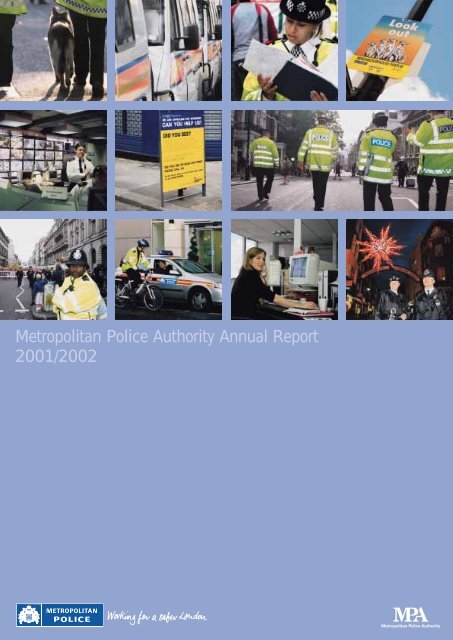


![Appendix 1 [PDF]](https://img.yumpu.com/51078997/1/184x260/appendix-1-pdf.jpg?quality=85)
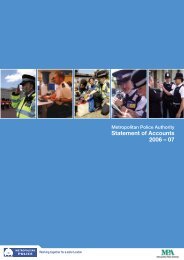
![Transcript of this meeting [PDF]](https://img.yumpu.com/50087310/1/184x260/transcript-of-this-meeting-pdf.jpg?quality=85)
![Street drinking in Hounslow [PDF]](https://img.yumpu.com/49411456/1/184x260/street-drinking-in-hounslow-pdf.jpg?quality=85)
